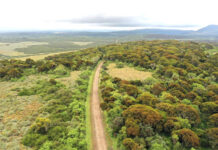By Fred Deya
Millions of Africans still lack access to electricity but a new generation of solar micro-grids could win support from investors and bring power to unlucky folks. Entasopia town is a centre of reference.
The life in Entasopia, about 40 kilometers off the nearest power line in Kenya’s deserted Rift Valley used to be hectic after the sun set.
However, the current situation of the remote Entasopia has changed since the installation of micro grid solar plant, thanks to SteamaCo, a Nairobi-based micro grid developing and Installation Company.
The solar plant at the middle of the dusty town is a kin to power revolution in the somewhat marginalized community after the installation of solar plant two years back.
The solar power plant is smartly built that allows them to remotely access and monitor the systems’ performance and capture consumer payments by a mobile money transfer mode.
In this manner, the technology is efficient and effective because it gives accurate power purchase by the locals.
John Pambio, Entasopia dweller who also monitors the solar hub has got a business that operates by the use of solar power.
The entrepreneur counts profits at his electronic kiosk as customers line up to drop their
mobile phones for recharge. He can also handle his electronics repair job with ease.
“I used to operate from Kiserian, 95 kilometers from this place because of lack of electricity in this place. The current situation is lucrative because I so depend on this solar power than never before”, narrates Pambio.
According to Pambio, the power demand surges at night when light is needed. He said that area residents depend on solar power mostly at night when their TVs, sound systems are turned on, and when they need to extend their business after sunset.
Pambio is among the Entasopia solar project beneficiaries. The venture aims at providing reliable pwer to dwellers of remote areas of southern savannah.
The 24 solar panels are connected to 24-hours power storage battery which is able to generate about 6 Kilowatts. The generated energy is enough to supply a wide radius in the area; serving business facilities, and lighting nearby homesteads.
The system is connected to a control box, which is beneath the solar panels and a smart meter that controls power to each customer. The system uses payment software that uses the remote, disconnecting power when the purchased credit is used up.
Even though the power charge is seen as expensive to low-incomers in the area, but in the real sense it is cheaper than kerosene for lanterns and diesel-fueled generators.
“SteamCo is one of the companies that tap into growing internalization. There is perception that developing communities are too poor to use sophisticated energy services which should not be the case”, said Sam Duby, company’s founder and technical director.
Duby acknowledged the present of the solar plant, said that it is cheaper to be built than the traditional grid-tied coal plants. He said that the plant has the ability to spread power to a couple of many customers. ‘People in this town are able to boost service over standalone solar’, added Duby.
According to Duby, the SteamaCo is to partner with equity bank I order to speed its solar power supply expansion. “This business looks benefiting. Even though most of our customers are poor, they have learned to purchase the power and know how to sparingly use it”, said Duby.
SteamaCo director said that the solar plant at Entasopia is likely to have paid for itself within a decade. The revenue worth $10,000 was used in its first year. According to Duby, the full take off of the solar plant would showcase the change to rural Kenya.
Joseph Osula Nyagilo, SteamaCo managing director in Nairobi town said that the micro grid system of solar plant effective and efficient as people avoid running up and down looking for connections.
“The system uses software that controls the cashless purchase of power by our customers.” Said Nyagilo. He added the deserted Entasopia have been misquoted but it an area worth investment as long as the constant power is on.
The solar expert acknowledged the boost of investment in the area since the installation of the solar plant. He said that there is rise in business like power welding, barbershops, as well night business extension which was not there before.
Over 100 households are already benefiting from the solar power with over 700 individual are directly in access to the power supply.














